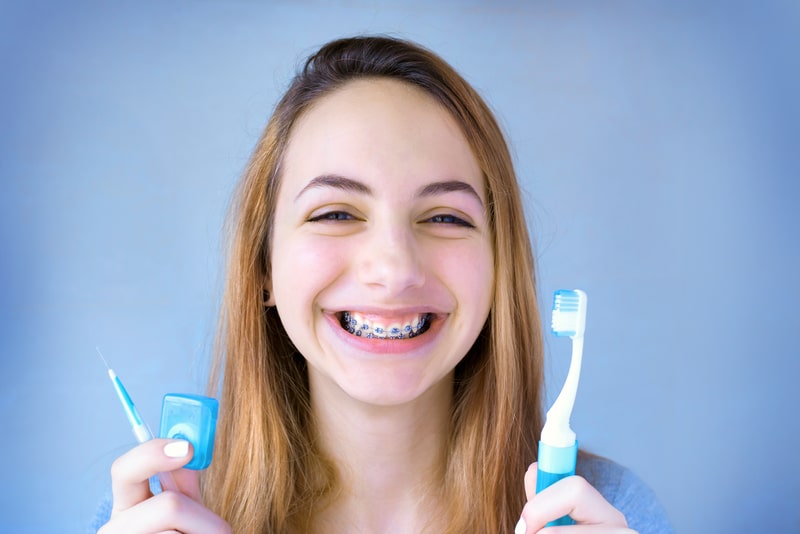Oral Hygiene During Braces


Studies show that not enough people are taking care of their oral health through proper brushing and flossing. It’s even harder to take care of your teeth when you have braces. Even though you are seeing an orthodontist with braces, you still have to see your dentist and be meticulous about your oral hygiene. If not, you could experience lots of tooth decay, problems with gum disease, tooth erosion, white stains and more. Avoid those problems with these tips!
Oral Hygiene In America
Do you skip brushing your teeth sometimes? If so, you are not alone. Studies show that not enough people are brushing their teeth, flossing or visiting the dentist. This is probably the reason why tooth decay and gum disease is out of control. In fact:
- The National Institutes of Health reports that tooth decay is the most “chronic, prevalent disease” among children and adults.
- About 92% of people in the United States have had cavities, despite the U.S. being a country with great dental care available.
- Gum disease is not far behind tooth decay, as 64.7 million Americans are plagued by gum disease. That number only reflects American adults, as even children can have this disease.
- Both are caused by a lack of oral hygiene care and dental visits.
- Only about 65% of adults visit the dentist, and many only once a year. That percentage has stayed consistent throughout the 2000s.
- The CDC reports dental visits in 2015 for children as being 84.7%. Adults between 18 and 64 saw the dentist at a rate of 64% and those over 65 were around 62.7%.
- The American Dental Association (ADA) recommends that every person (even infants) should see the dentist at least twice a year for comprehensive exams and dental cleanings. Many people don’t know this recommendation.

Oral Hygiene with Metal and Ceramic Braces
You can know that you are caring for your braces correctly if you go to your biannual dental visits. If your oral hygiene is lacking, we can let you know. Many people—especially children and teens—have metal and ceramic braces. The care for these are very similar, as they both have bracket-and-wire designs on your teeth. Make sure you:
- Brush after every meal. The ADA recommends that people brush at least twice a day. However, with braces, brush after every meal, even if you have to take oral hygiene kits to work or school. Extra cleanings can dislodge stuck food and prevent cavities even more.
- Floss every day. Do this at least once, if not day and night. Use floss threaders or threadable floss, which you stick through the spaces in between your teeth. You can thread the floss through your teeth like a sewing needle and floss like usually if you thread your floss. We can show you in-office how to do this.
- Use a Waterpik. This is a device that shoots water. It can dislodge stuck food and blast it out of brackets.
- Use a proxabrush. This looks like a tiny Christmas Tree brush. It can clean out stuck food in brackets and wires easier than a toothbrush.
- Use fluoride toothpaste. Fluoride can help protect your teeth from demineralization and tooth decay.
Oral Hygiene with Invisalign Treatment
If you are a teen or adult, you may be eligible for Invisalign treatment, which is a series of transparent aligners that you switch out each week. The aligners fit snug and gently shift your teeth straighter as you switch them out each week. With your oral hygiene, you simply remove the aligners and brush and floss like normal. If you have weak enamel or are prone to tooth decay or gum problems, this may be the best option for you.

What to Watch For
You may be taking great care of your teeth, but you can still get a horde of cavities because of what you are putting in your mouth. Food and drinks can destroy your tooth enamel, especially with braces. Here are some foods to watch for and avoid if you can:
- Soda and Carbonated Beverages: Carbonation is made possible by a combination of water and carbonic acid. That acid creates those fizzy bubbles you love, but it also takes layers off of your tooth enamel. Don’t brush for 30 minutes after a carbonated drink, as the working acids can take off even more tooth enamel.
- Citrus: This includes both citric drinks (like lemonade) and citrus fruits. Both contain citric acid, which has the same effect as carbonation does. If you eat citric fruits, wait 30 minutes and use fluoride toothpaste when you brush.
- Hard Candies/Mints: Avoid hard candies or mints during braces, as these expose your teeth to sugar for long amounts of time. That sugar means more decay.
- Hard Foods: Cook your veggies (like carrots) instead of enjoying them raw, as these could break appliances. Also be careful of apples and other hard fruits and veggies you bite into.
- Snacks: Some snacks can break appliances or become stuck in your braces or gums. Avoid nuts, popcorn (because of the hulls) and chips at all costs if you can.
- Sticky Treats: These become stuck in the braces, which can mean sugar is stuck on your teeth for long periods, creating decay. Sticky treats include gum, taffy, licorice, gummies, fruit snacks, dried fruit, caramels, Skittles, Starburst, Tootsie Rolls and similar items.
- Ice: Never chew on ice, even without braces. This can break and crack teeth.
Healthy Habits, Healthy Smiles
You will spend 18-24 months in braces if you are a teen or adult. Children might spend two separate times in braces if they have bite and alignment issues. Don’t let that time go to waste! Keep up on your oral hygiene during braces and avoid certain foods and drinks if you want a beautiful smile when those braces come off. For more oral hygiene tips with braces, call Dr. Ania’s office today at 303-443-0998!


